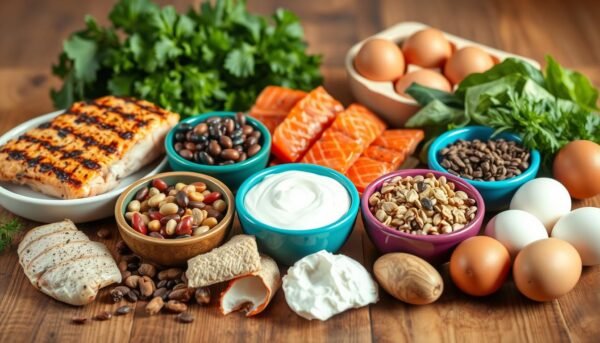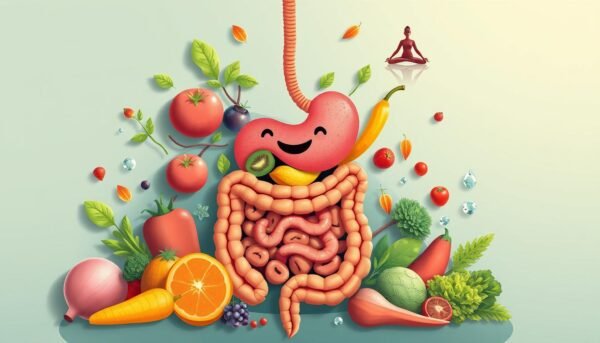As I turned 40, I noticed big changes in my body. Losing weight was no longer easy. But I didn’t let my age stop me from finding healthy ways to lose weight.
I’ve learned a lot about weight management in my 40s. Hormonal and metabolic changes make it tough. Yet, with the right strategies, losing weight and staying healthy is possible at any age.
Understanding the Challenges of Weight Management in Your 40s

As we age, our bodies change in ways that make losing weight harder. Hormonal shifts during menopause can lower estrogen, affecting how we handle insulin and increasing hunger. Also, muscle loss starts after 40, slowing down our metabolism.
Hormonal Changes and Their Impact on Weight
The drop in estrogen during menopause affects weight. Lower estrogen means more fat, especially around the belly. It also makes it harder to control blood sugar and cravings.
Age-Related Metabolic Shifts
Our metabolism slows down with age. Women lose muscle at a rate of 3-8% per decade starting in their 30s. This muscle loss makes it harder to burn calories and keep a healthy weight.
Common Barriers to Weight Loss After 40
- Busy schedules and competing priorities that make it challenging to prioritize healthy habits
- Increased stress levels, which can disrupt sleep and contribute to emotional eating
- Changes in daily routines and social circles, leading to less support and more temptation
Overcoming these challenges needs a plan that includes good food, exercise, stress control, and hormone balance. By understanding these changes, people in their 40s can create a plan to stay healthy.
Essential Nutrition Strategies for Midlife Weight Management

Managing weight in our 40s can be tough. Hormonal and metabolic changes make it harder to lose weight. But, by focusing on key dietary strategies, we can beat these challenges and lose weight for good.
Protein is key. Eat 20-30 grams of protein at meals and 10-15 grams in snacks. This helps keep muscle mass, boosts metabolism, and keeps you full. Choose lean proteins like chicken, fish, legumes, and Greek yogurt for your goals.
- Eat fiber-rich foods to feel full and control blood sugar.
- Add healthy fats from avocados, nuts, and olive oil to block bad hormones and support health.
- Make meals balanced with lots of fruits and veggies. They give you vitamins, minerals, and antioxidants to keep your body going.
By using these nutrition tips, you can manage your weight in your 40s. A good plan includes diet, exercise, and managing stress. This combo is key to staying healthy at this age.
Smart Protein Choices for Sustainable Weight Loss

Protein is key for weight control, especially as we age. Choosing the right protein can help keep muscle, control hunger, and boost metabolism. Let’s look at some smart protein picks for a healthy weight loss journey.
Optimal Protein Portions Throughout the Day
It’s important to spread out your protein intake. Aim for 20-30 grams at each meal and snack. This helps keep muscle and controls hunger. Good sources include lean meats, fish, eggs, and plant-based options like legumes and quinoa.
Best Protein Sources for Adults Over 40
Here are top protein sources for adults over 40:
- Salmon, with 39.3 grams of protein per 178-gram serving
- Chicken breast, offering about 22.5 grams of protein per 100-gram serving
- Greek yogurt, with around 19.9 grams of protein per 200-gram serving
- Eggs, containing 6.3 grams of protein per large egg
- Legumes, like chickpeas and lentils, are high in protein and fiber
Timing Your Protein Intake
Think about when you eat protein. Try to have a protein-rich snack or meal within 30 minutes of working out. This supports muscle recovery and growth. It’s vital for a healthy metabolism and weight control.
The Power of Mindful Eating After Forty

As we get older, mindful eating can change our lives. It means paying attention to when we’re hungry and enjoying our food. We should eat without distractions, like phones.
By listening to our bodies, we can spot why we eat emotionally. This helps us choose the right foods and the right amounts.
Using smaller plates is a simple trick. It helps us eat the right amount without eating too much. Knowing how food affects us helps us make better choices. This way, we can stay healthy after 40.
| Mindful Eating Practices | Benefits |
|---|---|
| Eat Slowly and Savor Each Bite | Allows you to feel satisfied with less food, promoting portion control |
| Avoid Distractions During Meals | Helps you stay present and attuned to emotional eating triggers |
| Pay Attention to Hunger and Fullness Cues | Enables you to stop eating when you’re satisfied, not overly full |
| Identify Emotional Eating Patterns | Helps you develop alternative coping strategies instead of turning to food |
Mindful eating gives us back control over food. It supports our health and wellness in midlife.
Losing Weight After 40: A Comprehensive Approach

It’s tough to lose weight after 40, but it’s doable. Focus on changing your diet and lifestyle. Here are some tips to help you lose weight and stay healthy in your 40s.
Creating a Sustainable Meal Plan
Start with a balanced meal plan. Eat whole grains, lean proteins, fruits, and veggies. Stay away from processed foods with bad fats, sugars, and artificial stuff.
Drinking one less soda a day can save 3,360 calories. That’s almost a pound lost each week.
Lifestyle Modifications That Work
Healthy eating is just part of the equation. Exercise is key. Try to move for at least 150 minutes a week, like walking fast or swimming.
Do strength training twice a week to keep or grow muscle. Small changes, like taking stairs, help too.
Don’t forget about stress and sleep. Yoga, meditation, and 7-9 hours of sleep are vital. Daily weigh-ins and drinking tea can also help.
Weight loss is a journey, not a goal. Be patient and celebrate small wins. With a good meal plan, exercise, and healthy habits, you can reach your goals and stay healthy in your 40s and beyond.
Strategic Exercise Plans for Middle-Age Weight Loss

Managing weight in our 40s is tough. A smart exercise plan is key. Mix cardio, strength training, and flexibility for the best results.
Do 20-30 minutes of resistance training, like weightlifting, twice a week. This helps keep and build muscle. It’s vital as we age and losing weight gets harder.
- Try high-intensity interval training (HIIT) to boost your metabolism and burn fat. HIIT is better for losing fat than steady exercise.
- Yoga or Pilates can improve flexibility, balance, and reduce stress. They help with weight loss.
- Low-impact exercises like swimming or biking are good for your joints and heart.
Finding the right mix of exercises is important. Aim for 4-5 workouts a week. Mix strength, cardio, and flexibility.
| Exercise Type | Frequency | Duration |
|---|---|---|
| Strength Training | 2-3 sessions per week | 20-30 minutes |
| HIIT | 2 sessions per week | 27 minutes |
| Moderate-Intensity Aerobic | 1-2 sessions per week | 60 minutes or longer |
With a balanced exercise plan, you can reach your weight loss over 40 goals. Stay fit and healthy as a middle-aged adult.
Sleep and Stress Management for Weight Control

Keeping a healthy weight can be tough as we get older. But, sleep and stress management are key. Good sleep and stress control can help you lose weight after 40.
Optimizing Sleep Quality
Try to sleep 7 to 9 hours each night. A regular sleep schedule and a calm bedtime routine help control hunger hormones. This is important for appetite and metabolism.
Make sure your sleep area is cool, dark, and quiet. This helps your body sleep well and control weight.
Stress-Reduction Techniques
- Try mindful meditation or deep breathing to lower stress hormones. This helps with weight control.
- Do yoga or light exercises to reduce stress and feel better.
- Do things that calm you down, like journaling or listening to music. Being in nature also helps.
Too much stress can make you gain weight. It makes your body store fat instead of burning it. Adding stress-reducing activities to your life can help you manage your weight and health.
| Benefit | Impact on Weight Loss |
|---|---|
| Improved Sleep Quality | Regulates hunger hormones, boosts metabolism, and supports fat burning. |
| Stress Reduction | Lowers cortisol levels, preventing stress-induced weight gain and promoting healthy weight management. |
Focus on sleep and stress management for a better weight loss plan. These steps help you avoid unhealthy weight loss after 40.
The Role of Gut Health in Weight Management

Keeping your gut healthy is key for losing weight. Studies show that the balance of gut bacteria affects weight management.
Eating fermented foods like yogurt and sauerkraut adds good bacteria to your gut. These foods help your gut stay healthy. They also affect how you feel hungry and how well you absorb nutrients.
It’s also important to eat foods rich in prebiotics. Prebiotics feed the good bacteria in your gut. Foods like bananas and whole grains are great for this.
A healthy gut can help control hunger hormones. It also helps your body burn calories better. This is good for managing weight.
Adding probiotics and prebiotics to your diet can help with weight loss. It’s a simple way to improve your health.
| Probiotic Strain | Potential Benefits for Weight Management |
|---|---|
| Lactobacillus gasseri | May help reduce body weight and belly fat |
| Bifidobacterium species | Can contribute to weight loss and prevent weight gain |
| VSL#3 (a probiotic blend) | May prevent weight gain and insulin resistance |
Probiotics work differently based on the type and amount used. Talking to a doctor can help find the best probiotic for you.
Portion Control and Meal Timing Strategies

Keeping a healthy weight after 40 needs smart planning. Knowing the right portion sizes and when to eat helps. This way, you can keep your calorie intake in check and manage your weight over time.
Understanding Serving Sizes
Learning the right serving sizes is key to portion control. Studies show that fast food portions have grown too big, leading to eating more than we need. To fix this, use visual aids and measuring tools to guide you.
- Use smaller plates and bowls to control your portions.
- Learn about recommended serving sizes, like a palm for carbs or a fist for protein.
- Measure your food with scales, cups, or spoons to get the right amount.
- Notice how different plate colors can affect how much you think you’re eating.
Optimal Meal Scheduling
Meal timing is also crucial for weight loss. Practices like intermittent fasting or time-restricted eating can help manage calories and boost metabolism.
- Eat most of your calories in the morning, avoiding snacks at night.
- Try a fasting window, like 16 hours fasting and 8 hours eating, to improve metabolism.
- Eat slowly, taking 15-20 minutes before having seconds.
- Drink water before meals to feel fuller and eat less.
Mastering portion control and meal timing can greatly help you reach your weight goals. It’s a big step towards a healthy lifestyle after 40.
| Meal Timing Strategies | Benefits |
|---|---|
| Intermittent Fasting | Regulates metabolism, supports weight loss, and improves insulin sensitivity. |
| Time-Restricted Eating | Reduces overall calorie intake and helps manage hunger and cravings. |
| Consuming Calories Earlier in the Day | Aligns with the body’s natural circadian rhythms and prevents late-night snacking. |
| Drinking Water Before Meals | Promotes a feeling of fullness and can lead to reduced calorie consumption. |
Incorporating Healthy Fats and Fiber
As we get older, adding healthy fats and fiber to our diet is key. Foods like avocados, nuts, and olive oil are full of good fats. They help us feel full and keep us healthy. Fiber-rich foods also play a big role in managing weight.
Try to eat 25-30 grams of fiber every day. You can find it in fruits, veggies, whole grains, and legumes. Foods like chia seeds, black beans, and raspberries are great sources of fiber. They help control blood sugar, keep you full, and support your digestive system.
- Soluble fiber, found in oats, legumes, and certain fruits and vegetables, can help stabilize blood sugar and promote feelings of fullness.
- Insoluble fiber, present in whole grains, nuts, and seeds, aids in maintaining digestive regularity and reducing the risk of certain cancers.
- Psyllium husk, a soluble fiber supplement, can also assist with weight loss by enhancing gut health and managing hunger hormones.
By mixing healthy fats and fiber, you can make a diet that’s both tasty and good for you. Start slowly with fiber to avoid stomach issues. Try to add a high-fiber food to each meal.
But, managing weight in midlife is more than just fiber and fats. Look into other ways like eating mindfully, getting enough protein, and exercising. These can help you reach your weight loss goals and keep you healthy.
Building and Maintaining Muscle Mass After 40
As I hit my 40s, I’ve learned how key it is to build and keep muscle. Sarcopenia, or muscle loss with age, starts early. So, I focus on strength training to fight this.
I use compound exercises like squats and push-ups. They work many muscles at once. I also do isolation exercises to target specific muscles.
Eating right is also key. I eat more protein, about 1.6-2.2 grams per kilogram of my weight. This helps my muscles grow and repair. With the right diet and exercises, I’m on track to keep my muscles strong.
This post may contain affiliate links which means I may receive a commission for purchases made through links. I will only recommend products that I have personally used! Learn more on my Private Policy page.